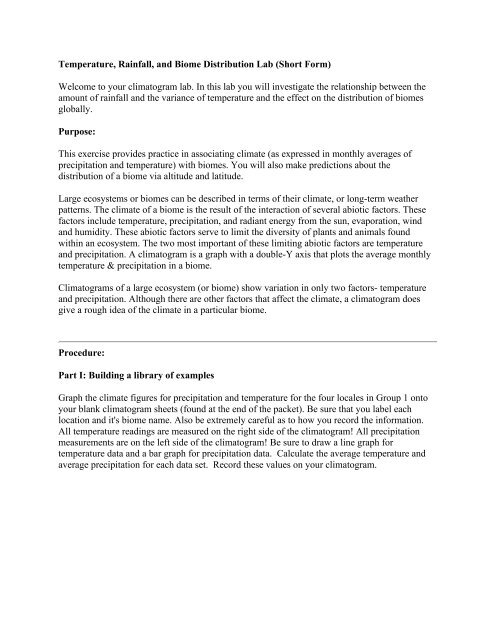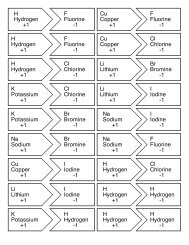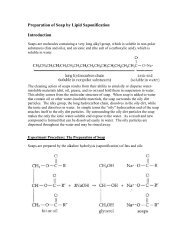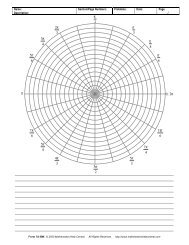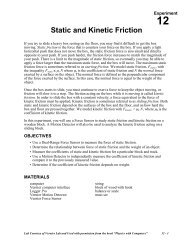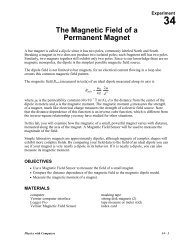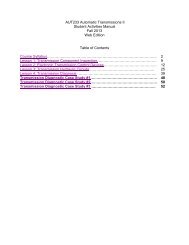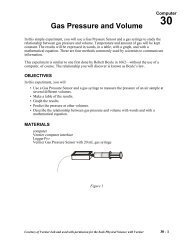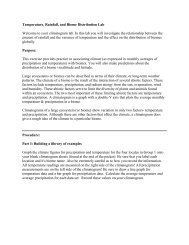Temperature, Rainfall, And Biome Distribution Lab (Short Form)
Temperature, Rainfall, And Biome Distribution Lab (Short Form)
Temperature, Rainfall, And Biome Distribution Lab (Short Form)
Create successful ePaper yourself
Turn your PDF publications into a flip-book with our unique Google optimized e-Paper software.
<strong>Temperature</strong>, <strong>Rainfall</strong>, and <strong>Biome</strong> <strong>Distribution</strong> <strong>Lab</strong> (<strong>Short</strong> <strong>Form</strong>)Welcome to your climatogram lab. In this lab you will investigate the relationship between theamount of rainfall and the variance of temperature and the effect on the distribution of biomesglobally.Purpose:This exercise provides practice in associating climate (as expressed in monthly averages ofprecipitation and temperature) with biomes. You will also make predictions about thedistribution of a biome via altitude and latitude.Large ecosystems or biomes can be described in terms of their climate, or long-term weatherpatterns. The climate of a biome is the result of the interaction of several abiotic factors. Thesefactors include temperature, precipitation, and radiant energy from the sun, evaporation, windand humidity. These abiotic factors serve to limit the diversity of plants and animals foundwithin an ecosystem. The two most important of these limiting abiotic factors are temperatureand precipitation. A climatogram is a graph with a double-Y axis that plots the average monthlytemperature & precipitation in a biome.Climatograms of a large ecosystem (or biome) show variation in only two factors- temperatureand precipitation. Although there are other factors that affect the climate, a climatogram doesgive a rough idea of the climate in a particular biome.Procedure:Part I: Building a library of examplesGraph the climate figures for precipitation and temperature for the four locales in Group 1 ontoyour blank climatogram sheets (found at the end of the packet). Be sure that you label eachlocation and it's biome name. Also be extremely careful as to how you record the information.All temperature readings are measured on the right side of the climatogram! All precipitationmeasurements are on the left side of the climatogram! Be sure to draw a line graph fortemperature data and a bar graph for precipitation data. Calculate the average temperature andaverage precipitation for each data set. Record these values on your climatogram.
Combined with the six climatograms given below as examples (see below), you nowhave ten climatograms representing ten different biomes found worldwide.
Part II: San FranciscoNow graph the information for San Francisco.Precipitation(in cm):<strong>Temperature</strong>(in C°):J F M A M J J A S O N D4.5 2.8 2.6 1.5 0.3 0.1 0 0.1 0.2 1.1 2.5 3.513.0 15.0 16.0 17.0 17.0 19.0 18.0 18.0 21.0 20.0 17.0 14.0Average <strong>Rainfall</strong> in cm: __________________Average <strong>Temperature</strong> in Celsius: __________Compare the climatogram for San Francisco with the ten known <strong>Biome</strong>s from Part I.
Answer the following questions about San Francisco and the other biomes you havecataloged.1) What biome is San Francisco found in? Consult your textbook.2) Which of the known biome climatograms closely resembles San Francisco?a. In what ways were they similar?b. In what ways were they different?c. Would you consider them to truly be the same biome? Explain?d. During the thirty-year period used for the figures in the San Franciscoclimatogram there were four drought periods. How would this effect theappearance of the climatogram?
3) How are the Tundra and Desert similar? Different?a. Similarb.Different-4) How are the Tropical Rain and Tropical Deciduous Forests similar? Different?a. Similarb.Different-5) Lawrence, Kansas and Nashville, Tennessee occupy similar latitudes. Why is onefound in grassland and the other in a forest biome?6) Considering that the information in your climatograms is presented on a monthlybasis. How would you determine which biomes are located in the southernhemisphere?7) Which biome has the:a. Most rainfallb.Least rainfallc.The highest average temperatured.The lowest average temperaturee.Most consistent year round temperaturef.Most variable year round temperature-


